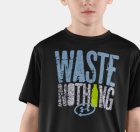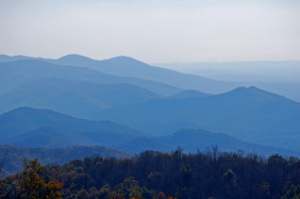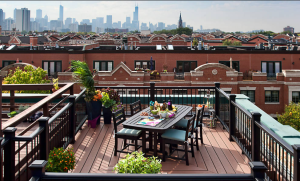Making the Best of Waste: Innovation, Jobs and Profits

Anybody reading this post wearing an Under Armour item of apparel right now? Does it happen to be the Catalyst tee as described above by UA?
Well, back in 2011, when UA was selling less of everything ($1.47B) than it is today ($2.33B), it made this Built for the Future claim: “…we estimate that we will convert over 2,000,000 one liter plastic bottles into performance products. Today, our Catalyst line of UA Green products utilizes up to 4 recycled water bottles in each piece of apparel.” This is part of its pledge to make products with lesser environmental impact.
In the tandem piece, Committed to Improvement, UA says: “We recognize that the environmental footprint of our products comes from more than the raw materials used in production. We are committed to extending our focus beyond recycled raw materials. We seek to understand and improve the manufacturing, packaging, dying, printing, and other facets of our products’ environmental footprint in an ongoing effort to lessen our impact on the environment.” In a statement about energy use: “For every kWh of electricity we use, we’ve elected to purchase one kWh of certified clean, green wind power from the grid. We will continue to find ways to reduce the energy used to run our business. Finally, addressing its own waste: “Under Armour® will continue to find ways to reduce and reuse the waste it creates”.
See this 1-minute video about how it makes its green clothing products-
This company, founded in 1996, is the brain-child of founder/CEO Kevin Plank who grew up in Kensington, MD, and played football while a student at the University of Maryland. It was there that he began experimenting with synthetic materials for a higher-performance tee shirt that wicked perspiration more effectively than traditional cotton. It’s a Baltimore-based company with worldwide product sales.
Skyline view from a Trex deck
My next question could be: who has used or added a Trex product for a porch, deck, railing, exterior trim, pergola or fencing? At its essence, Trex are wood-alternative composite building products.
Do you know that Trex recycles discarded plastic–over 1.3 billion plastic grocery tote bags annually–and wood dust in the manufacture of its products? 95% of all product is a combination of recycled wood (reduced to saw dust) and plastic. This recycled product translates into 400 million pounds of plastic and wood diverted from landfills each year. Trex product lines are sold in big-boxers Home Depot and Lowe’s, and to wholesale distributors selling to retail lumber yards, such as 84 Lumber, around the country.
When building a screen porch last fall, I specified Trex decking material. Its light gray was the perfect color, but, much more importantly, the decking is pretty much maintenance-free. Oh, sure, a bucket of Earth Friendly Products’ “Orange Plus All Purpose Cleaner-Degreaser Concentrate” well-diluted and swabbed or broomed over the material, then hosed down once a year isn’t a bad idea. Or, it can be gently power-washed less frequently to similar effect. And, it will significantly outlast traditional wood decking.
Unlike traditional wood decking, Trex
- will not warp or rot due to harsh weather
- is splinter-free
- doesn’t need sanding, staining or painting, ever
From its webpage about how green its production line is: “…our factory runoff and refuse are recycled back into the manufacturing line. Our trailers [used within its plant to transport wood dust] even run on vegetable-based oil hydraulics.”
While struggling during the Great Recession of 2008-09, when new building and renovation projects were severely stemmed due to financial turbulence surrounding 8.4 million jobs lost in the U.S. economy, the company has rebounded well since 2011 in tandem with renewed consumer confidence.
Here’s a 3+minute video from Trex on how it makes its eco-friendly product-
Originally formed in 1996, resulting a buyout of a Mobil Oil division, this is a Winchester, VA-based company.
Disclosure: I own stock in both of these companies, but am promoting them, if you will, solely for their exception green merits.
Post Script:
Two landmark pieces of legislation, the Wilderness Bill and the Land and Water Conservation Fund Bill, were signed into law by LBJ 50 years ago this month. Here are his remarks which are worthy of skimming, at least. Or, a commentary in National Geographic.



